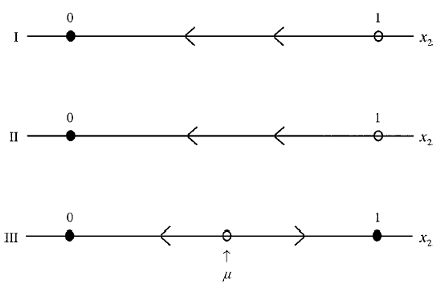In our dynamic playing-the-field contest without fundamental
risk; the resulting population dynamic is given in (30). Given the interior steady state µ the equilibria of the dynamic have three categories depending on the average sentiment
P¤ and the noise trader risk
(I) If noise traders on average have negative sentiment (P¤ < 0); then rational traders as a group will dominate the economy in the long run.
(II) If noise trader risk is small or if average investor sentiment is positive
but not moderate; then rational traders as a group will dominate the economy in the long run.
(III) If noise trader risk is large and if average investor sentiment is moderate; then rational (nonrational) traders as a group will dominate the economy in the long run when the initial population share of the nonrational traders; x2(0) ; is below (above) the threshold level µ.
Figure 3 illustrates the evolution of the population share of the noise traders as a group according to Theorem 2.1 under each of the three categories. The intuition of Theorem 2.1 is as follows. In category I, noise traders with a negative average sentiment, P¤ < 0, tend to hold less of the undervalued risky asset and, as a result, lose money to the rational traders who hold more of the risky asset. In category II with positive average sentiment,P¤ > 0, consider an extreme case where the noise trader risk is negligible relative to the average sentiment such that 
In this special case with neither fundamental risk nor, effectively, noise trader risk, the noise traders who overestimate the expected future price of the risky asset will trade extremely large quantity and, as a result, lose arbitrarily large profits in trading against rational traders with unlimited arbitrage. Category III corresponds to the case where noise traders have positive sentiment and the noise trader risk,
 is relatively large. With a positive sentiment, noise traders tend to hold more of the risky asset and consequently push up the price of
is relatively large. With a positive sentiment, noise traders tend to hold more of the risky asset and consequently push up the price of
the risky asset (see Eq. (23).) On the other hand, the large noise trader risk tends to trim noise traders’ aggressive trading and hence eliminate some of the price


x2 is the population share of the group of type-2 (i.e., nonrational) traders.
pressure. Such a price reduction effect increases with the presence of noise traders (see Eq. (23).) Therefore, if the presence of the noise traders is large enough, i.e., x2(t) > µ, then the noise traders’ moderately aggressive trading will generate greater returns than the rational traders do. On the other hand, if the presence of the noise traders is not large enough, i.e., x2(t) < µ, then rational traders are more willing to bet against the noise traders’ misperception and, as a result, exploit profits from it. Note that DSSW’s (1990) long run dynamic without fundamental risk is essentially the same as our category III, while our categories I and II are absent.
Prof. F. Albert Wang
Next: Dynamic Playing-The-Field Contest with Fundamental Risk
Summary: Index